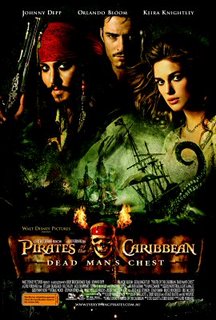 [Image from EmpireMovies.com]
[Image from EmpireMovies.com]Richard Linklater's A SCANNER DARKLY is the first adaptation of Philip K. Dick that I've seen that captures the feel of his writing. Faithfully adapted by Linklater and directed in the same live-action-to-animation style as the director's WAKING LIFE, A SCANNER DARKLY has the same low-key intensity as its literary progenitor, a subtle wrongness that pervades the action in between moments of out-and-out surrealism. It's a finely crafted little film, slight on the plot side, low on intensity, but evocative and atmospheric and powerful. In short, it's what I'd hoped for when I first heard of the project, and I have to commend Linklater and company for sticking to their guns throughout. PKD may be one of the most adapted authors in science fiction, but this is the first time anyone's really gotten him.
Keanu Reeves is Bob Arctor, an undercover DEA agent in a near-future where the drug of choice is Substance D, a vaguely defined chemical compound which is highly addictive and has the long-term effect of separating the hemispheres of the brain and pitting them against each other. He lives as an addict with James Barris (Robert Downey Jr.) and Ernie Luckman (Woody Harrelson), in an increasingly dilapidated old house. To his superiors he's known only as "Fred"- they're watching the group (including Bob's girlfriend Donna, played by Winona Ryder) and suspect that someone there can lead them up the ladder to a big supplier, but they don't know which one of them he is. (At work he wears a "scramble suit" which masks his appearance, as does his supervisor and other workers.) So you might imagine Bob is already having identity issues, on top of what the drug is slowly doing to him. It's his slow decline which drives the story, such as it is.
In the meantime, there are the rants, the scares and the insane plans which drug-addled minds cook up, presented in casual and naturalistic detail. Philip K. Dick's novel was partly autobiographical, a sad and angry memoir of the people he knew and lost to drug abuse (comparing them in an afterword to children playing in the middle of the road.) It's not really about the plot, but the experience of knowing and watching these people and the erosion of their lives. Not that the film will be embraced by the Partnership for a Drug Free America anytime soon; the national War on Drugs is indicted as part of the problem, creating both supply and demand, and Bob's own work trying to combat Substance D requires him to become more addicted to it. There are many for whom the experience of watching the lives of hopeless drug addicts does not seem like a pleasant filmgoing experience, and this film probably won't convert them. For this kind of film you have to have a tolerance for shady and/or foolish characters who make bad decisions and don't realize just how shitty their lives are.
The animation, as noted, is the same kind on display in Linklater's WAKING LIFE (and a number of commercials since), in which animators effectively draw over a live action plate, creating an eerie kind of fluid motion which allows the visuals to slide easily from the real to the unreal. The style also helps to reflect the uncertainty Arctor feels about his own reality, an uncertainty shared by many other characters as well. Finally, it's just plain beautiful, possessed of a painterly quality and making the most squalid vistas strangely compelling. Particularly hypnotic are the conversations between "Fred" and his supervisor "Hank", both wearing the ever-shifting scramble suits which every second project hundreds of image fragments of men, women, and children of all appearances (both characters also speaking in altered voices.) It's one of the many genuinely clever concepts Dick created in his career, and to see it realized well on screen is a hoot.
Reeves may possess a somewhat limited range, but it serves him well here; Arctor is not meant to be outgoing or highly emotional, and he moves and speaks in the proper tone. Ryder and Harrelson also play to type well, their real-life reputations creating interesting connotations (a rarely exploited benefit of having well-known actors.) Robert Downey Jr., no stranger to infamy himself, provides a brilliant manic counterpoint as the manipulative and demented Barris, who at times seems almost a threat to those around him as opposed to just himself. Also notable is Rory Cochrane as Charles Freck, a fellow addict with a bad case of DTs whose lavish suicide attempt provides an interesting interlude.
By far the finest decision Linklater made was the inclusion of part of Philip K. Dick's original postscript, a dedication to many of the friends he'd seen harmed by drug abuse, their names and damages listed, many deceased by the time Dick was writing. As in the original book, a subtle but palpable sadness and anger is present, but also empathy and compassion. This is a powerful piece of work in its own small way.
These were comrades whom I had; there are no better. They remain in my mind, and the enemy will never be forgiven. The "enemy" was their mistake in playing. Let them all play again, in some other way, and let them be happy.
Grade: A-







